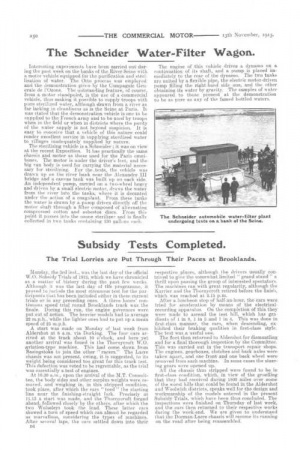Subsidy Tests Completed.
Page 18

If you've noticed an error in this article please click here to report it so we can fix it.
Monday, the rd inst., was the last day of the official W.O. Subsidy Trials of 1913, which we have chronicled as a matter of history during the past few weeks. Although it was the last day of tire programme, it proved to include the most strenuous test for the participants that has been included either in these current trials or in any preceding ones. A three hours' continuous speed trial round Brooklands track was the finale. During this run, the engine governors were put out of action. The heavier models had to average 22 m.p.h.,'while the lighter ones had to put up a mean speed of 25 mph.
A start was made on Monday of last week from Aldershot at 8 a.m. via Dorking. The four cars arrived at the track about 10 o'clock, and here yet another arrival was found in the Thornycroft W.O. aviation-type machine. This had come down from Basingstoke to join the other "racers." The Lacre chassis was not present, owing, it is suggested, to its weight being considered too great for this track test. This defection was voted to be regrettable, as the trial was essentially a test of engines.
At 10.30 a.m., upon the arrival of the M.T. Committee, the body sides and other surplus weights were removed, and weighing in, in this stripped condition, took place, after which the ears " toed " the starting line near the finishing-straight fork. Precisely at 11.15 a start was made, and the Thornycroft forged ahead, followed closely by the others, after which the two Wolseleys took the lead. These latter cars showed a turn of speed which can almost be regarded as marvellous, considering the types of machines. After several laps, the cars settled down into their respective places, although the drivers usually contrived to give the somewhat limited " grand stand" thrill upon passing the group of interested spectators. The machines ran with great regularity, although the Karrier and the Thornycroft retired before the finish, which was reached at 2.15 p.m.
After a luncheon stop of half-an-hour, the cars were tried for acceleration by means of the electricalrecording apparatus. On the completion of this they were made to ascend the test hill, which has gradients of 1 in 8, 1 in 5 and 1 in 4. This was done in first-class manner, the cars, when descending, exhibited their braking qualities in first-class style. The test was a useful one.
The fleet then returned to Aldershot for dismantling and for a final thorough inspection by the Committee. This was carried out in the transport repair shops. The engines, gearboxes, clutches and hack axles were taken apart, and one front and one back wheel were removed from each machine. In some cases the steering gears were opened up. All the chassis thus stripped were found to be in first-class condition, which, in view of the gruelling that they had received during 1600 miles over some of the worst hills that could be found in the Aldershot and Woolwich districts, speaks well for the design and workmanship of the models entered in the present Subsidy Trials, which have been thus concluded. The inspections were finished on Thursday of last week, and the cars then returned to their respective works during the week-end. We are given to understand that the Dorman-Lacre chassis will resume its running on the road after being reassembled.
























